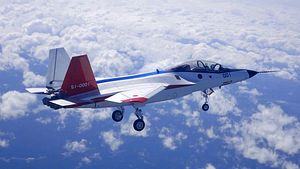The Japanese Ministry of Defense (MoD) confirmed that it has ruled out the development or local production of existing foreign-designed fighter jets to replace its fleet of F-2 multirole fighter aircraft, a Mitsubishi license-produced variant of Lockheed Martin’s F-16, by the 2030s, according to a MoD source.
The source said that the development and production of Japan’s new F-3 stealth fighter jet will be led by the country’s military aircraft industry with the possibility of collaboration with external partners including BAE Systems, Lockheed Martin, Boeing, and Northrop Grumman, Jane’s reports on February 4.
“Our F-2 fighters are expected to retire from the late 2030s,” the MoD spokesperson was quoted as saying on February 1 by Jane’s. “In order to acquire new fighters that are capable of playing a central role in a future networked force … the MoD will promote necessary research and launch, at an early timing, a Japan-led project with the possibility of international collaboration in sight.”
The program is expected to officially kick off this year in line with the Mid-Term Defense Program (MTDP) and the National Defense Program Guidelines (NDPG), which set out Japan Self-Defense Force (JSDF) capability targets over a period of about 10 years. The entire Future Fighter (F-3) Program is anticipated to take about 15 years.
In 2016, Japan unveiled an experimental fifth-generation fighter technology demonstrator, dubbed X-2 “Shinshin” (formerly the ATD-X), which was intended to serve as the basis for the F-3 fighter. However, Japan reportedly scrapped further development of the aircraft in 2018. Given the recent revelations, however, the X-2 platform could be revived as Mitsubishi Heavy Industries (MHI), the company that developed the X-2’s fuselage, is expected to take the lead in developing the F-3.
Japan has been looking for international partners to collaborate with MHI and various Japanese subcontractors on the F-3 for the past year. The MoD issued a request for information to international aircraft makers in 2018 for its stealth fighter program. BAE Systems, EADS, Lockheed Martin, Boeing, and Northrop Grumman reportedly responded to the request.
“U.S. aircraft maker Lockheed Martin, the purported frontrunner, has recently submitted a design proposal for a twin-engined air superiority fighter jet that combines the F-22’s airframe with the F-35’s electronic suite,” I wrote in August of last year. “ The proposal, however, has been dismissed as too expensive by Japan’s Ministry of Finance.”
The MoD intends to procure up to 100 new fifth-generation air superiority fighters at an estimated cost of $2o billion by the end of the 2030s. Notably, the cabinet of Japanese Prime Minister Shinzo Abe also approved an increase of Japan’s existing order for 42 fifth-generation Lightning II F-35A stealth fighter jets — the aircraft’s conventional takeoff and landing variant — to 147 of the aircraft last December.
































